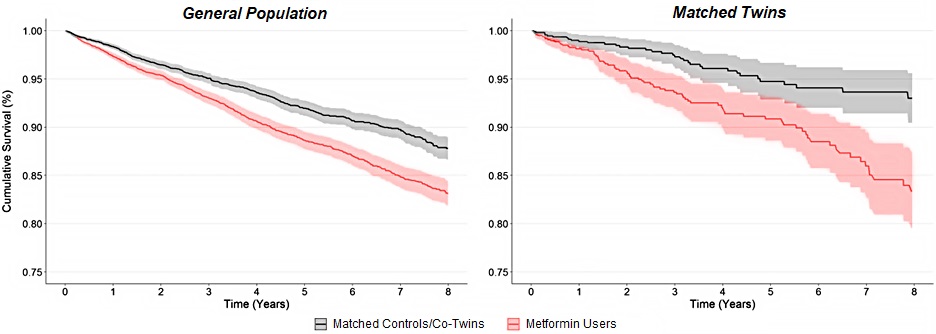
Short summary: In an earlier post we broke down the fatal flaw in the famous 2014 study that seemed to show that people with type 2 diabetics who take metformin live longer than people without the disease who don’t. In this update, we review two recent papers that address this question without the flaw in the 2014 study and find that, as expected, metformin is a good diabetes drug but shows no sign of being a longevity therapeutic.
In an earlier five-part series, I laid out the reasons to be skeptical that metformin would pan out as a longevity therapeutic. The centerpiece of the second post in the metformin series was a 2014 observational study by Bannister et al., which is the one study that is most often cited as evidence that metformin slows aging in humans. A press release that accompanied the Bannister paper wrongly stated that it showed that “Type 2 diabetics can live longer than people without the disease” if they take metformin.
If that were true, metformin would have to be doing a lot more than just normalizing abnormal blood sugar regulation. Having type 2 diabetes (T2D) robs a 50-year-old person of six years of life expectancy compared to a person who doesn’t have the disease, and simply lowering a diabetic’s blood sugar down to the low end of the diabetic range only claws back about four of those lost years. So if metformin could not only eliminate the life expectancy gap between diabetics and nondiabetics but actually enable a person with T2D to live longer than a similarly-situated nondiabetic, it would have to be doing something for their health beyond lowering blood sugar and exerting minor knock-on effects on other metabolic risk factors. And it would be worth spending a lot of money to determine if that “extra something” was slowing down the degenerative aging process in humans.
But as other scientists had pointed out before me, the Bannister study had a design flaw that first unintentionally selected only the healthiest diabetic patients (those on metformin) and compared them to patients whose blood sugar was harder to get under control (those on second-line diabetes medications) as well as to a random assortment of the nondiabetic population. Their study design then unwittingly but systematically pushed subjects who were taking metformin “off the books” as soon as their diabetes got worse. This methodological artifact created the illusion that metformin users lived longer lives than nondiabetics, because it meant that the study would only count metformin users as metformin users if they managed to stay healthy.

In the months since I wrote the original blog post explaining this, I’ve become aware of two other studies asking the same core question but using different methods — and they both find that, as you would expect, people on metformin for diabetes are shorter-lived than people without diabetes. Because these studies address this question more directly than any of the studies discussed in that blog post, we’ll review them here.
The first study took advantage of the centralized electronic medical records of patients in Wales. They identified patients diagnosed with T2D over 20 years starting in 1999 who were consistent users of either metformin or sulfonylureas. They then matched these patients one-to-one with people with similar health statuses (other than not being diabetics) and followed them up for up to 20 years.
T2D patients taking sulfonylureas suffered more deaths, more new cardiovascular disease, and more cancer than patients taking metformin. These worse outcomes might result from the different ways that sulfonylureas and metformin lower blood sugar, but clinical trials are inconclusive about the relative benefits of the two drugs (or of metformin compared to any of several older diabetes drugs). Instead, the shorter survival of sulfonylurea-treated patients in the Welsh observational study could be a version of what tripped up the Bannister study: the fact that doctors usually put people on metformin when they first develop T2D, and only switch them onto other drugs or add new ones on top of metformin if they get sicker. So in an observational study like this, a person taking a sulfonylurea will typically be in a more advanced state of diabetes than a person taking only metformin, and will thus be at a higher risk of death.
But the critical question for longevity therapeutics is not whether sulfonylureas are better or worse diabetes drugs than metformin, but whether metformin might have some anti-aging effect beyond its ability to normalize unhealthy glucose metabolism that would allow people with diabetes to live longer than nondiabetics. And having not fallen into the accounting error of the Bannister study, the answer in this new study was “no.” Instead, as you’d expect, the diabetic patients were about 60% more likely to die over the 20 years of the study than were people without diabetes, with much smaller differences among people with T2D using metformin to manage their disease versus those using sulfonylureas.
There is one caveat to that overall finding. In the first year after they started taking the drug, metformin users did actually seem to have lower mortality rates even than nondiabetics, just as the Bannister et al. had found. But that difference disappeared by year three, and had clearly reversed entirely by year five: from then on, the metformin users were clearly dying more often than the nondiabetic population.
What could explain that seemingly golden first year? One suggestion the authors make is that after having lived with either prediabetes or undiagnosed diabetes for years, a diabetes diagnosis (and accompanying metformin script) might have inspired other healthy lifestyle changes, which might have lowered their mortality risk for a little while, but then have been lost over time as the immediate shock of the diagnosis receded in their minds and they went back to their old habits. But if that were the explanation, you might expect the same thing to happen with a first sulfonylurea prescription, and no such effect was observed. On the other hand, if it was a real anti-aging effect, you would expect it to take some time to take hold and to persist for longer. And, of course, it might have been statistical noise that faded over time as the underlying biology of diabetes and aging dominated an unknown confounder.
Regardless of the explanation, the long-term effect on metformin was better than going untreated as a diabetic and seemingly better than having a sulfonylurea as a first drug, but its benefits were clearly not even enough to get them back on the miserable course of “normal” aging, let alone to have a real anti-aging effect.
Unfortunately, there wasn’t much opportunity in this study to look for anti-aging effects of two diabetes drugs that do hold some promise as longevity therapeutics: canagliflozin (which wasn’t approved until near the end of the study period) and acarbose (which is rarely used in Europe). But metformin was a bust.
The second new study tested the question from several different angles. In one analysis, they applied the Bannister study’s flawed analysis to their independent population of nearly half a million Dutch people. In another, people who started on metformin but required new or additional diabetes drugs in the analysis were kept in the metformin group (as they should have been) and were compared directly to people who had used other diabetes drugs or no diabetes drugs at all. And in a third analysis, they controlled for the effects of genetics and family background by comparing the survival of twins in whom one twin had gone on metformin while their co-twin of the same sex had either used other diabetes drugs or no diabetes drugs at all.
The second new study also took account of how much metformin people had taken: how long they’d been using it, how many times they got their prescription renewed, and how often they filed a prescription. And they made extra sure that their nondiabetic control group was nondiabetic — something for which Bannister et al. hadn’t accounted. This was a potentially impactful thing to suss out, because if the supposedly nondiabetic control group actually included people with unrecognized or untreated diabetes, it would make the metformin-treated diabetic patients look healthier for reasons other than the obvious factor of controlling blood sugar.
Conversely, the scientists running the second new study also did analyses in which they removed the few people they could identify as users of metformin for reasons other than diabetes, such as polycystic ovarian syndrome (PCOS).
As expected, people whose first diabetes medication was a sulfonylurea suffered more deaths than people who began with metformin. But even so, people who used metformin were about 50% more likely to die over the followup period as were nonusers of metformin. And the disparity was even more stark in the twin study: with the noise of genetics and family background removed, diabetic twins who used metformin were about twice as likely to die as their unexposed co-twin.

This basic finding held up no matter which subgroups they looked at and how they sliced and diced the data. Somewhat surprisingly, even a Bannister et al.-style analysis only modestly reduced the size of the effect, with metformin users being 39% more likely to die over the study period instead of 50%. And this was despite the fact that users of both sulfonylureas and metformin were much more likely to be using medications to lower apoB-containing lipoproteins like LDL, blood pressure, and blood clotting than did people with normal blood sugar regulation, which would have further reduced their risk of death from atherosclerotic cardiovascular disease.
To repeat: the likely explanation for this is not that metformin is a killer drug, any more than the explanation for the longer-lived metformin users in the Bannister et al. study was that it is a cheap generic longevity therapeutic. Instead, the reason that metformin users died more often than people not using diabetes medications is the obvious one. Being diabetic is ruinous to one’s health, and metformin can only do so much to protect people from a downward cycle of high blood sugar, insulin resistance, and failing insulin-producing beta-cells.
We shouldn’t stop looking for hidden benefits in common medications — and if we find good evidence that such a drug might slow something as terrible as degenerative aging, it may be worth it to follow that signal up with clinical trials. But with metformin, a story that emerged in cell culture and some poorly-designed animal and human observational studies have led many smart people astray.
And even if metformin had turned out to be as effective as it seemed to be in some of the early studies of metformin in abnormally short-lived animals, the implied potential benefits for aging humans would have been pretty modest. It would garner an aging humanity a much higher ROI if the media, many advocates, and scientists would redirect the resources and attention that have gone into metformin into developing therapies that directly repair the damage in aging tissues.
See also the other posts in this series:
- Part 1: on the animal data on metformin and aging;
- Part 2: on some human studies on metformin, including a flawed observational study that created the illusion that diabetics on metformin actually live longer than people without diabetes;
- Part 3: on human trials of metformin to prevent or treat cancer;
- Part 4: on human studies on metformin and age-related cognitive decline and dementia; and
- Part 5: on the backstory on TAME and how it might impact the push for longevity therapeutics.
- Addendum: Monkeying With the Clocks Via Metformin



